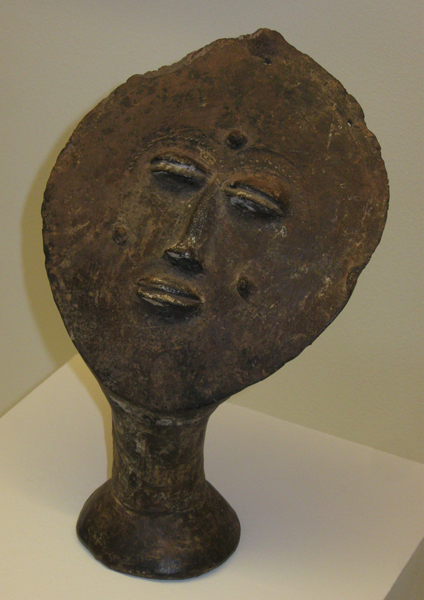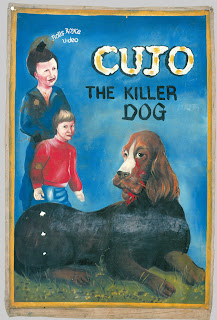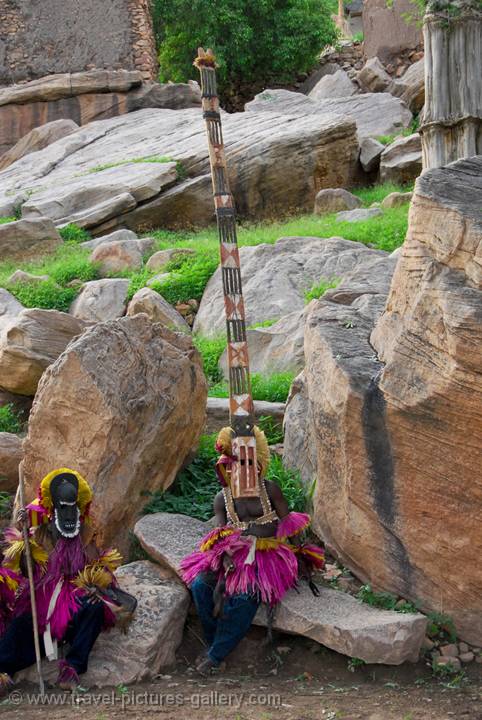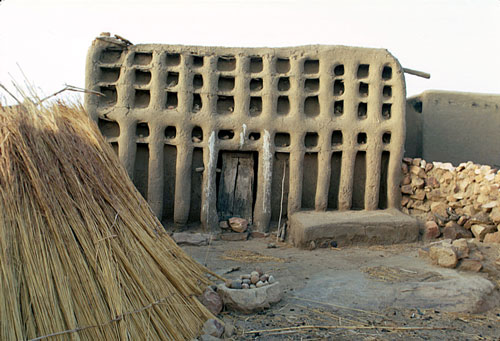This last week in class we did a lot of comparing different objects and different cultures. I decided to compare the Akan Terracotta Funerary Sculptures with the terracotta and brass Ile Ife heads.
The Terracotta Funerary sculptures were made by the Akan's in Ghana. These sculptures were used to commemorate the deceased. The clay included heads, heads attached to rudimentary bodies, and heads attached to funerary vessels. Most of the terracotta images were made by women. To others the sculptures do not appear to be exact realistic portraits, however the artists insist that it is a very close likeness of the deceased. Royal terracotta portraits were often displayed wearing fine cloth and and seated on chairs surrounded by terracotta and human attendants. The sculptures were then paraded through the streets to the royal graveyard. Until the last few decades the portraits did not display descriptive imitations of actual humans, but rather generic renderings of heads with a few individualizing characteristics, such as hair styles or scarification. Some heads were flat this was a reference to idealized beauty. Such heads are flat and thin, with simplified features. Others are fully round and naturalisticly modeled, these are simplified and idealized by showing neither age marks or blemishes. Many styles and types of heads are known suggesting developments and changes over several centuries.
The terracotta and brass heads are made by the Ile-Ife in Nigeria. Many of the heads discovered at Ile-Ife are complete works in themselves and are used on alters. In modeling the faces the artists have rendered the way flesh and muscle lie over bones. This naturalism embraces a degree of idealism. The brass heads show the same idealized naturalism as the terracotta heads. Like the terracotta heads they display the same idealized naturalism. The eyes, lips, and ears are styled according to ideal models. But the features are still individualized. The face has vertical striations found on many terracotta and brass heads made by the Ile-Ife. These markings are thought to be scarification or they may be purely an aesthetic device. There are also holes along the hairline probably used to attach a crown. Others have holes on the face just above the jaw line and across the upper lip, probably for attaching facial hair to make it look even more realistic or a beaded veil to hide the lower portion of the face. While many of the heads found at Ife once formed part of a larger figure, from most of these only fragments have survived.
Both of these sculptures portray idealism. Showing what is beauty. Even though the funerary sculptures look so abstract that we couldn't understand how it could possibly look realistic of a person. It could be a realistic portrayal of the persons personality. They're both made out of terracotta, and both have very intricate details or individualized characteristics. They're both made to honor people or a specific person that has died.

Friday, September 30, 2011
Friday, September 23, 2011
Masks and how they mark and effect change
How do masks mark and effect change? This is an interesting question that I will answer using the Bwa people as a example, but before I do we need to ask a few other questions. First what are the functions of masks? The answer to this is simple there are many different functions, however two of the main ones are that they are a form of theater and they are a form of worship. Who dances masks? the answer is young men. in Herbert M. Cole's essay it states that in one of the myths of the Dogon, Senufo, Baule, Kuba, and Igho people, women were the first to have the secrets of the masks and that women were the first masked dancers. After which the masks and their rituals were taken completely over by men, who then usually excluded women from all rites except as onlookers. Today women dance not with the masks but they can dance during the masquerades. The next question is who owns the masks? basically different families own different masks and will carve their own. Families such as the Bonde family in Burkina Faso consecrated a mask called the hornbill mask. On this mask there two colors black and white. Black symbolises knowledge and white symbolises those who are just beginning to learn. Another mask called the Do mask is made out of leaves it is typically danced at funerals and ensures the renewal of life. Yet another mask called the Serpent is danced at harvest time and helps the men be able to court and marry women. The story with the serpent mask is that a group of people from the Pa village tried to raid a nearby village for wives but they were ambushed and so they ran and took shelter in a snake hole crying out to the serpent save us and we will worship you. So the serpent agreed. The people built a mask to honor the serpent and from then on the men have been lucky in courtships. That's just one way that a mask has effected change. The last question is what seems to be the interaction between maskers and the audience? There is a variety of different interactions depending on the mask. Some maskers make fun of people in the audience. Others lash out at them in anger. While some people in the audience will get up and dance with the masks. Masks have authority over the dancers the same authority as a teacher. The masks are supposed to represent change. The change of a group of people over time. The dancer becomes embodied when he actually in a sense becomes the animal doing the same things that it does by actually in that moment becoming the animal or as Cole said in the essay, "Spirit characters vibrate between opposing forces and transcend them. The structural integrity of these binary oppositions, moreover, is in part defined by spirits who separate the two while simultaneously bringing them together. Ultimately, it seems, the mediator bridges the gulf between opposites and creates of them a kind of spiritual, conceptual, and cosmic unity. Many specific masking situations can be cited to exemplify this role of spirit as mediator and, finally, unifier. "Ancestral" maskers bring the "incarnate dead" into the realm of the living, linking these worlds and showing them to be one."
Bethany <><
Bethany <><
Friday, September 16, 2011
The Radiance of a King article
When I first read this article I didn't really know what to think. It's interesting how some Africans portray Obama or view him. They depict him different ways through flour sack posters. One such poster called Power House '08 has Obama and his African grandmother on a motorcycle that says "Change we can believe in." Close behind them is John McCain on a brown pony the flaps on the saddle read P.O.W. and "Nation First". As they race toward the White House it becomes clear who the artist wants to win this presidential race. Another poster depicts him as Super Man with a tag line that reads, "Obama ready to fly to the black and White House." As we talked about these posters in class I noted that one said, "Congrats on being the first black president." When I talked with my group most of us said that Obama being black had no pull in which way we voted. That's something that we never thought about during the presidential race because the way we saw it was that it doesn't matter what color skin you have we're all the same. What did matter in the race was the world views of each party. Even though I don't necessarily agree with the posters in that Obama was the perfect choice for president, they are still interesting to look at. One thing that Ernie Wolfe stated in this article that I liked was, "There's a theme of unity in many of these paintings, they reference peace, getting along, black and white sharing: Democrat or Republican. We are one Nation. Creme or Chocolate."
These African artists don't just paint presidential posters but they also create movie posters. What do I mean by this you ask? I mean that they are not the real posters for the movie, but they are recreated posters of what the artist thinks the message of the movie is or they adapt the poster to what they think the movie means or is about. Some of the posters get pretty insane and your not sure what movie influenced it. The process used for these posters is simply oil paint on flour sacks.
These African artists don't just paint presidential posters but they also create movie posters. What do I mean by this you ask? I mean that they are not the real posters for the movie, but they are recreated posters of what the artist thinks the message of the movie is or they adapt the poster to what they think the movie means or is about. Some of the posters get pretty insane and your not sure what movie influenced it. The process used for these posters is simply oil paint on flour sacks.
Friday, September 9, 2011
Batiking
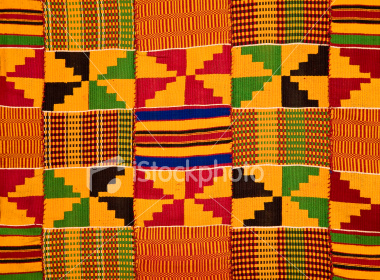 |
| Kente strips sewn together |
 |
| "Nayme" |
 |
| "Except God" |
Bethany <><
Friday, September 2, 2011
Arts of Africa 1
Coming into this class I didn't know much about Africa at all, and here we are at the end of the second week of school and I already know ten times more than I did before. One group of peoples that we talked about was the Dogons. The Dogons make many masks, most of the masks have a funerary function. One of these masks is called the Great Mask or the "Mother of all Masks". This mask dose not get put on and danced around, but rather is more of an alter mask that is used to empower all Dogon masquerading. When a man dies this mask is brought out of it's cave and leaned against the ginna where the body is laid. A live chicken is then attached to the top and the death is proclaimed to the mask as if it were a living breathing being. After sacrifices are made some men dance with the mask and then return it to it's cave.
Another mask is called the Sirige. It's also called, "Ladder", "Tree", and "Big House". This mask is similar to the Great Mask, but smaller. The Sirige is painted with many triangular motifs that alternate with open rectangular shapes and repeated all the way up the long plank. the rectangles are interpreted as the many generations of a great family.
We also talked about family shrines. These shrines were buildings constructed with adobe in a rectangular shape, with many rectangular holes. The shape and symmetric structure of the building conveys order. When a member of the family died they would put something that was important to or valuable to that person in one of the rectangular holes to honor and celebrate that persons life.
I have learned so much already in these first two weeks of college and I'm looking forward to learning more.
Bethany <><
Another mask is called the Sirige. It's also called, "Ladder", "Tree", and "Big House". This mask is similar to the Great Mask, but smaller. The Sirige is painted with many triangular motifs that alternate with open rectangular shapes and repeated all the way up the long plank. the rectangles are interpreted as the many generations of a great family.
We also talked about family shrines. These shrines were buildings constructed with adobe in a rectangular shape, with many rectangular holes. The shape and symmetric structure of the building conveys order. When a member of the family died they would put something that was important to or valuable to that person in one of the rectangular holes to honor and celebrate that persons life.
I have learned so much already in these first two weeks of college and I'm looking forward to learning more.
Bethany <><
Subscribe to:
Posts (Atom)
